How do you tell the age of chickens?

You can tell the age of a chicken by looking at the legs and feet, the feathers, the vent and the general condition of the bird.
Determining the age of chickens can be difficult once they get to a certain age. Beyond around 30 weeks it can be hard going to tell how old chickens are but there are a few tell tale signs that will give you a clue to the age of the bird.
Below: My oldest chicken is at least 11 and is a happy tatty mess.
The legs and feet of chickens are one of the biggest giveaways when trying to tell how old chickens are.
How can I tell how old a chicken is?
There are a few ways to tell the age of chickens. Here are some of the most common methods:
- Feathers. The feathers of a chicken can give you a good indication of its age. For example, young chickens will have fluffy down feathers, while older chickens will have smooth, adult feathers.
- Egg Production: If a hen is laying eggs every day, it's a good indicator that she is sexually mature, typically around 4 to 6 months of age. Declining eggs numbers are an indicator of age. However, keep in mind that factors like breed, nutrition, and lighting conditions can affect the onset of egg-laying.
- Comb and wattles. The comb and wattles of a chicken are also good indicators of its age. In young chickens, the comb and wattles will be small and pale. As the chicken ages, the comb and wattles will become larger and more colourful.
- Behaviour. The behaviour of a chicken can also give you a clue as to its age. Young chickens are typically more active and playful, while older chickens are more sedate and may even become broody.
- Leg Colour: Young chicks often have lighter coloured legs, which may darken as they grow older. For example, some breeds have yellow legs when young, which turn into a darker shade as they mature.
- Spur Growth: Roosters develop spurs on the back of their legs as they mature. These bony protrusions are used for defence and can give you an idea of the rooster's age.
- Moult. Chickens moult their feathers once a year. The moult usually starts in the fall and can last for several weeks. If you know when your chickens hatched, you can use the moult to estimate their age. For example, if your chickens hatched in the spring, and they are currently moulting, they are likely about 1 year old.
- Look for signs of wear and tear. Older chickens may have feathers that are missing or damaged. They may also have a few bald spots.
- Check the condition of the feet and legs. The feet and legs of older chickens may be more callused and worn.
- Feel the weight of the chicken. Older chickens may be slightly heavier than younger chickens.
By paying attention to these factors, you can get a good idea of the age of your chickens. This information can be helpful for making decisions about their care and management.
Working out the age of chickens is a bit hit and miss but there are a few things which will give you an idea of the age of the hen. It can be useful to know the age of the chicken, you don't want to pay good money for an old bird sold as a point of lay pullet.
Ways to tell the age of hens:
Is is handy to know how old chickens are, you don't want to be buying old birds.
Below: The legs of a young pullet about six months of age. You can see the legs are very yellow, clean and shiny with no missing scales.

Also the toes are all straight and the nails a good length.
Below: The legs of older hens for comparison. This three year old chicken where the legs are much more scaly and dark. If you look closely in the second picture you can see a vestigial spur on the hens legs, indicating that she is at least 18 months of age.
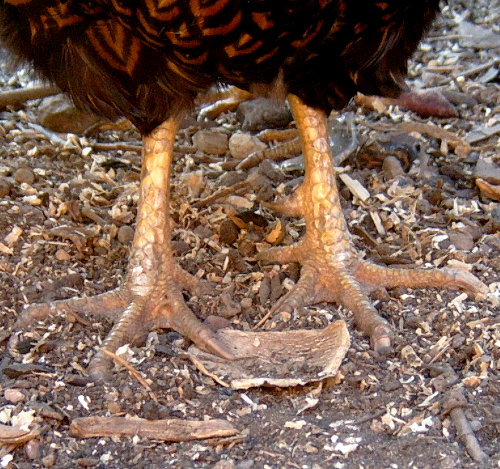
I'm not sure why older hens sometimes grow vestigial spurs such as this. This is an indication that the hen is at least 18 months old as they grow very slowly in hens.
I did read somewhere that in certain breeds of chicken, the spurs are a sought after requirement in the hens.
Chicken age chart with pictures:
Here is a chicken age chart:
| Age | Picture | Description |
|---|---|---|
Day-old
|  | Chicks hatch with down feathers and their eyes open. They are completely dependent on their mother or keeper for food and warmth. |
| 1-4 weeks | 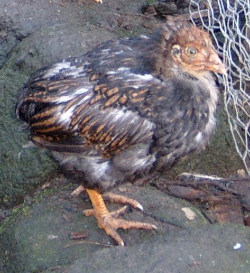 | Chicks start to grow their adult feathers. They are still dependent on their mother for food, but they are starting to explore their surroundings. |
| 5-12 weeks | 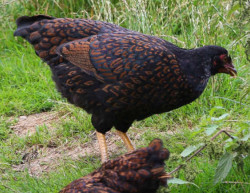 | Chicks are considered "teenagers" or "growers" at this age. They are starting to become independent and they are learning how to live on their own. |
| 13-16 weeks | 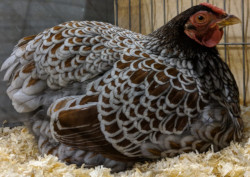 | They continue to develop and their secondary sexual characteristics begin to show. |
| 17 to 35 weeks | 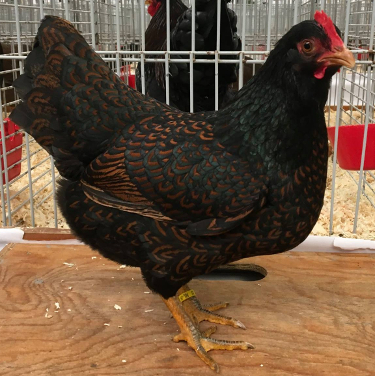 | This is the point of lay. Pullets (female chickens) will start to lay their first eggs at this age. Cockerels (male chickens) will start to crow and become more aggressive. |
| 1-3 years |  | Chickens are considered prime adults at this age. They will reach their peak egg-laying production during this time. |
| 4-5 years | 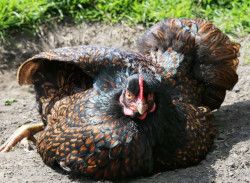 | Chickens start to slow down their egg-laying production at this age. |
| 6-8 years | 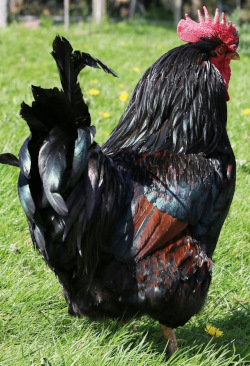 | Chickens are considered senior citizens at this age. They may lay fewer eggs, but they are still healthy and active. |
| 9+ years |  | Some chickens can live for up to 10 years. However, most chickens will start to decline in health at this age and will need to be humanely euthanized. |
It is important to note that these are just general guidelines. The age of a chicken can vary depending on the breed, the individual bird, and its environment.
How to tell the age of cockerels or roosters:
The primary way you tell the age of a rooster or cockerel is by looking at the spurs. A male with no spurs is less than 12 months old and after that they grow at 4 to 8 mm a year.
A cockerels spurs have rings on them enabling you to tell exactly how old they are.
Below: Baggy, scarred or misshapen eyes can betray and old chicken.
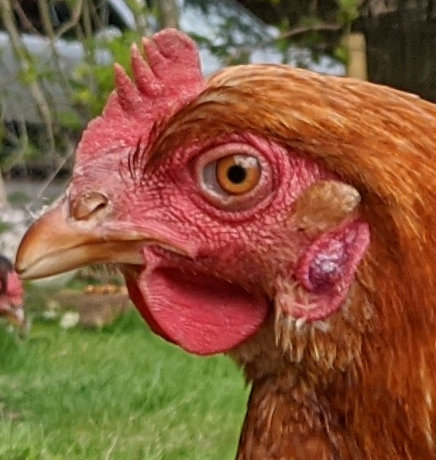
While you can not tell the exact age of a fully grown chicken, you will be able to find out if she's past her prime. The colours in her legs, beak and wattles progressively fade with age and there are many other signs that give clues to the age of chickens.
Signs of age in chickens:
- Breastbone: The breastbone is softer and pliable in a chicken under 1 year old, in the second year it will become quite firm. Young birds may feel light as they have yet to fill out.
- Feathers: As Chickens moult and change at least some their feathers every year this is not necessarily an accurate method of determining their age. The feathers can give an indication of age, only if the hen has not changed all her feathers in the moult you will see that some are more ragged and faded in colour. If you are looking at a chickens that has some faded feathers feathers and some new feathers mixed in, then it is likely at least 18 months old.
Roosters can disrupt this as they leave the hens with bald patches on their backs and if a flock has has a feather pecking problem this will make the birds seem older. - Combs: Combs get bigger and droopier as chickens get older although this is complicated by the breeds that have been bred to have large floppy combs, like the Leghorn. Have a close look at the comb to see if there is missing tips, damage or scarring. The combs and wattles get bigger, fade in colour and may go floppy in older birds.
- Beak: The beak continues to grow throughout the life of a chicken. It will gradually get more more slanted and longer with age and the top half may overgrow the bottom and curl downwards somewhat.The beak will be shiny in a young bird but will go a bit darker and rougher in an older one.
- Feet: An older chicken have worn and discoloured feet with thicker, longer toenails and missing scales.
- Vent: If the vent is bright and pink with a glossy sheen, and appears elastic or pliable the chicken is a younger age and still worthy of keeping.If the vent appears greyish or very lightly coloured pink and dry, and appears waxy then the chicken is older. A pullet that has not yet laid an egg yet will have a more rounded vent, while one who has started will have a flattened vent.
- Crop: A pendulous or low hanging crop is a sign of an old chicken.
- Eyes: Sometimes the eyes lids can be droopy and parts of the sclera that are not normally visible can be seen.
- Spurs: Spurs get longer as chickens age. Some hens grow spurs, oddly sometimes only one. The rings on a spur will tell you the age of the chicken in years.
- Activity: Older cockerels may not be as horny or energetic as younger birds fertility declines as they age.
- General condition: Long or twisted toenails, scarring, especially on the face or comb or damaged toes. Hens older then 4-5 years begin getting droopy and stressed looking.
How long do chickens live?
A chicken lives an average of 8 years. Matilda, the oldest certified chicken lived to be 14 years of age and a reader recently wrote to me with a case of Dolly who turns 14 years old on Feb 1st 2021 and laid 4 eggs in 2019 at the tender age of 12.
An update on Dolly who is currently the oldest (unconfirmed) living chicken at 15 years and 6 months old (April 2022).
Below: Dolly enjoying her retirement.
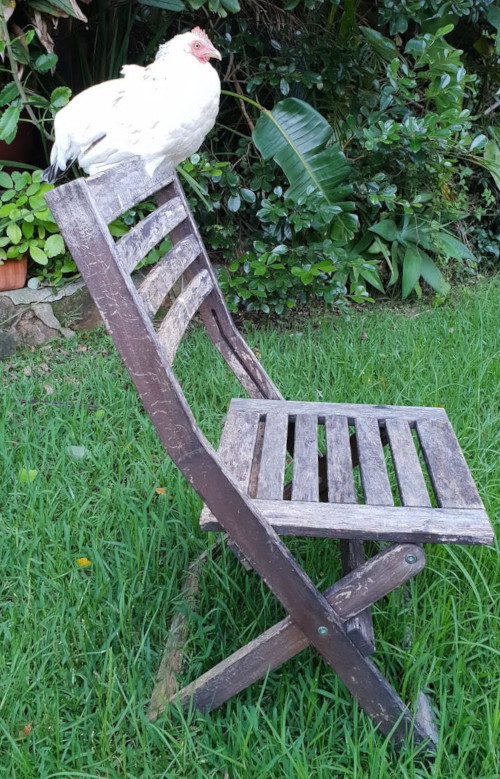
Many factors effect the age chickens can live to, some breeds live longer than others. I have found my Silkies to be longer lived, mostly because they never stress themselves with the laying of eggs!
Below: Dolly showing that the secret to a long and happy retirement is lush green backyard and a friendship with a brush turkey.
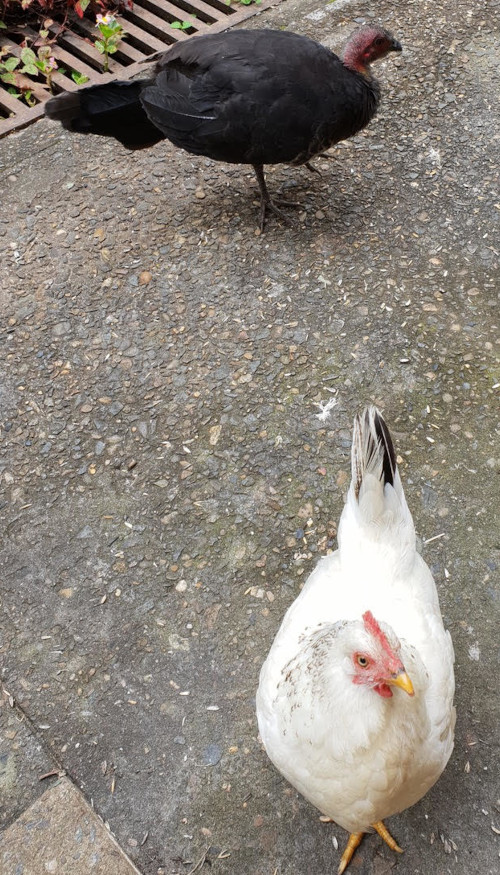
Hybrids, on the other hand, often burn themselves out laying so many eggs that they rarely live more than 3 or 4 years. Less than 5% of my red sex links make it to 5.
Care, local predators and the feed and conditions all contribute to life expectancy.
A hen near the end of her life will have skin and legs that are very pale and will be inactive.
The productive age limit for a chicken is 7 years old and many will cease to lay completely by this time.
